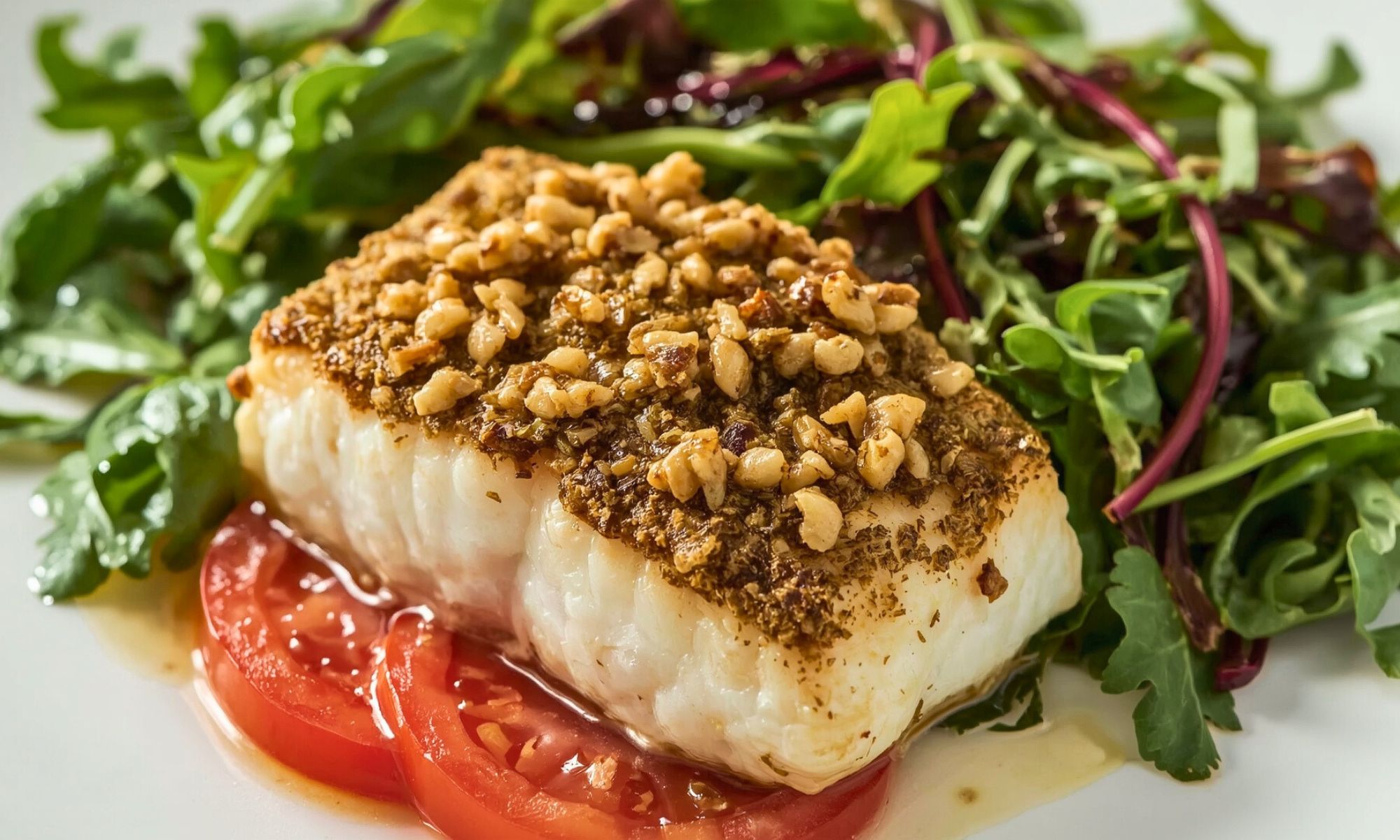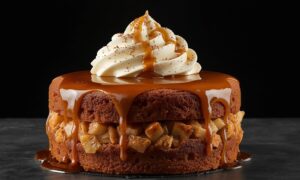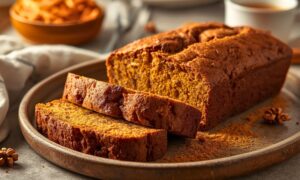Keto Chilean Seabass with Walnut Pesto Crust is what happens when comfort food meets a touch of elegance on a weeknight. You know that moment when the day leaves you drained, but you still crave something indulgent and satisfying? That was me one quiet evening, with a pristine fillet of Chilean seabass, a jar of toasted walnuts, and a stubborn refusal to settle for ordinary.
I blended the walnuts with fresh basil, lemon, and olive oil into a vibrant, nutty pesto, then pressed it over the fish before baking. The crust turned golden and crisp at the edges, while the seabass beneath stayed buttery and flaky, every bite delivering rich warmth and bright, herbaceous lift.
In the recipe ahead, I’ll guide you through building that irresistible crust, cooking the seabass to perfection, and serving it with sides that make the flavors shine. Trust me, once you taste this, you’ll make it on repeat
Why This Keto Chilean Seabass Recipe Changes Everything

Chilean seabass doesn’t need babying, it craves bold treatment. This fish has enough natural fat to stay moist and forgiving, making it perfect for this walnut pesto technique. What most home cooks don’t realize is that this particular fish actually improves with confident handling.
The magic happens in the crust itself. We’re creating textural contrast that seals moisture while adding aromatic herbs and toasted nuts. The walnuts turn golden and nutty, releasing oils that complement the fish’s natural richness. The basil stays bright and fresh, providing that herbaceous lift that cuts through all that luxurious fat. The fish underneath becomes incredibly tender, almost custard like in texture.
Here’s something interesting about Chilean seabass, it’s actually Patagonian toothfish, harvested from the pristine waters around Antarctica. This cold water environment creates fish with incredibly dense, flaky flesh and high omega-3 content. That’s why it commands premium prices and why it’s worth investing in this preparation method.
This keto Chilean seabass with walnut pesto crust proves healthy eating doesn’t mean boring food. The healthy fats from walnuts and olive oil, combined with protein rich fish, keep you satisfied without carb crashes. You’re getting roughly 45 grams of protein and 25 grams of healthy fats per serving, with virtually no carbs.
The technique itself draws inspiration from classic Italian and Mediterranean cooking, where nuts have been used to create crusts for centuries. But we’re adapting it for modern keto lifestyles without sacrificing any of that traditional flavor depth.
Essential Ingredients for Perfect Keto Chilean Seabass with Walnut Pesto Crust
Here’s what you need, listed in cooking order:
For the fish:
- 4 Chilean seabass fillets (6 oz each)
- 2 tablespoons avocado oil
- Salt and freshly cracked black pepper
- 1 lemon (for juice and zest)
For the walnut pesto crust:
- 1 cup raw walnuts
- 2 cups fresh basil leaves (packed tight)
- 3 garlic cloves
- 1/2 cup extra virgin olive oil
- 1/2 cup freshly grated Parmesan cheese
- 1/4 teaspoon red pepper flakes (optional)
- Salt to taste
Smart Ingredient Swaps That Work
Can’t find Chilean seabass? Black cod or halibut work beautifully. They have similar fat content and flake structure. Just adjust cooking time, halibut cooks faster.
Walnut allergy? Pine nuts are classic pesto choices. Pecans bring interesting sweetness. Even toasted sunflower seeds work well.
No fresh basil? Use half basil, half spinach. Spinach adds bulk and nutrition while basil carries flavor. Don’t try all dried herbs, you’ll lose that bright taste this keto Chilean seabass with walnut pesto crust needs.
Parmesan too expensive? Pecorino Romano is sharper and cheaper. Try aged Asiago for something different.
Step by Step Keto Chilean Seabass with Walnut Pesto Crust
Step 1: Prep Your Workspace Preheat oven to 425°F. Line baking sheet with parchment paper. Trust me, cleanup becomes effortless and nothing sticks.
Step 2: Create the Pesto Base Pulse walnuts in food processor until roughly chopped. Don’t make powder,you want texture. Add garlic and pulse. Add basil leaves and pulse until roughly chopped.
Here’s where people mess up: they add oil all at once. Start the processor running and drizzle olive oil slowly through the feed tube. This creates proper emulsion for your crust.
Step 3: Season and Adjust Add Parmesan, red pepper flakes, and salt. Pulse to combine. Taste now with a spoon. The pesto should taste bright, garlicky, and rich. Need more salt? Add it.
Step 4: Prep the Fish Pat fillets completely dry with paper towels. Surface moisture prevents proper searing. Season both sides generously with salt and pepper. Let them sit at room temperature for 10 minutes.
Step 5: Master the Searing Secret Heat large oven safe skillet over medium high heat. Add avocado oil, it has higher smoke point than olive oil. When oil shimmers, place fillets presentation side down first.
Don’t move them! Let them sear 3-4 minutes until golden. Flip once and sear other side 2 minutes.
Step 6: Apply Crust and Finish Remove pan from heat. Squeeze fresh lemon juice over fish. Spread walnut pesto evenly over each fillet. Press gently so it sticks.
Transfer whole pan to oven. Bake 8-12 minutes depending on thickness. Fish is done when it flakes easily but looks slightly translucent in center.
The Science Behind Perfect Keto Chilean Seabass

Here’s what happens in that oven: walnut oils toast gently while protecting delicate fish underneath. Parmesan creates tiny pockets of umami rich crispiness. Basil releases essential oils without burning because nuts and oil protect it.
Chilean seabass has amazing quality, enough fat to baste itself while cooking. The muscle fibers are loose and large, which explains why it flakes beautifully and why slight overcooking won’t ruin it. This is completely different from lean fish like cod or sole, which turn rubbery when overcooked.
The fat content in Chilean seabass ranges from 15-20%, compared to most white fish that hover around 1-3%. This high fat content creates that signature buttery mouthfeel and makes it incredibly forgiving for home cooks. It’s essentially impossible to dry out if you’re paying attention.
Initial searing creates Maillard reaction, complex flavors and aromas develop when proteins meet high heat. That’s your flavor foundation. This browning process creates hundreds of new flavor compounds that add depth and complexity you simply can’t get from baking alone.
The walnut crust acts as insulation, preventing the fish from overcooking while the nuts toast and the herbs bloom. It’s like having a built in temperature control system that ensures even cooking throughout.
Temperature matters more than time. Internal temp should hit 135°F for perfect doneness. Above 145°F moves into well done territory, which isn’t bad, but you lose buttery texture. Use an instant read thermometer inserted into the thickest part, it’s the only reliable way to nail perfect doneness every time.
Making Your Keto Chilean Seabass Restaurant Beautiful
Presentation starts with warm plates. Heat plates in 200°F oven for few minutes. This keeps fish at optimal serving temperature longer.
The walnut pesto crust should look golden and slightly crispy. If browning too fast, tent with foil. If not browning enough, hit with broiler for last minute, but watch carefully.
Garnish simply. Few microgreens or fresh basil leaves work perfectly. Lemon wedge is classic, bright acidity cuts through richness beautifully.
For sides, think color and texture contrast. Roasted asparagus with almonds, sautéed spinach with garlic, or simple arugula salad with lemon dressing. Let this beautiful keto Chilean seabass with walnut pesto crust be the star.
Perfect Pairings for Keto Chilean Seabass

Wine wise, choose something that won’t compete with bold pesto flavors. Crisp Sauvignon Blanc or unoaked Chardonnay work beautifully. Acidity cuts through richness while fruit notes complement fish’s natural sweetness.
Prefer red wine? Go light and earthy, Oregon or Burgundy Pinot Noir. Avoid anything too tannic or heavy that would overpower delicate fish.
For non alcoholic options, try sparkling water with lemon and herbs, or cucumber mint infused water that cleanses palate between bites.
Mastering This Keto Chilean Seabass Technique
This Keto Chilean Seabass with Walnut Pesto Crust represents everything I love about cooking, taking premium ingredients and treating them with respect while adding flavor layers and texture. It’s elegant enough for company but approachable for Tuesday night dinners. The beauty is that it looks and tastes like something from a high-end restaurant, but the technique is surprisingly straightforward once you understand the principles.
The beauty lies in flexibility. Once you master basic technique, play with pesto ingredients. Try pistachios instead of walnuts for a more delicate flavor. Add sun-dried tomatoes for sweetness and acidity. Swap different herbs based on what’s fresh, try mixing in some fresh oregano or thyme alongside the basil.
I’ve made this dish with macadamia nuts when I couldn’t find walnuts, and it was absolutely spectacular. The creamier texture of macadamias created an almost truffle-like richness that paired beautifully with the fish. Don’t be afraid to experiment once you’ve mastered the basic method.
The key to success with any variation is maintaining the proper ratio of nuts to herbs to oil. Too many nuts and the crust becomes heavy. Too much oil and it won’t hold together. Too many herbs and the flavors become muddy. It’s all about balance.
Remember, cooking requires confidence as much as technique. Trust your instincts, taste as you go, don’t be afraid to adjust seasonings. Don’t follow recipes blindly without engaging your senses. Your palate is the best guide you have.
Most importantly, this isn’t just about staying keto, it’s about proving healthy eating doesn’t mean boring food. When you combine quality ingredients with solid technique, you create something satisfying on every level.
Ultimately, the Keto Chilean Seabass with Walnut Pesto Crust is proof that restriction can spark creativity. Every component serves a purpose, every flavor builds on the last, and the result is something you’ll crave making again and again.
Frequently Asked Questions
How do I know when my keto Chilean seabass is properly cooked?
Fish should flake easily when tested with fork, but still look slightly translucent in center. Internal temperature should reach 135°F for perfect doneness. Overcooked Chilean seabass won’t be ruined like other fish, it stays moist, but loses some buttery texture.
Can I make walnut pesto for this keto Chilean seabass ahead?
Absolutely! Pesto improves after sitting few hours as flavors meld. Store in fridge up to 3 days, or freeze up to 3 months. Bring to room temperature before using. You might need extra olive oil if it seems thick.
What if my keto Chilean seabass crust browns too quickly?
Cover loosely with foil and continue cooking until fish is done. Lower oven temperature to 400°F and cook longer. Goal is properly cooked fish with golden, crispy crust.
Can I make this keto Chilean seabass dairy free?
Sure! Replace Parmesan with nutritional yeast for similar umami flavor. Try hard aged goat cheese if you tolerate goat dairy. Skip cheese entirely and add tablespoon miso paste for savory depth.
How should I store leftover keto Chilean seabass?
Store covered in fridge up to 2 days. For reheating, use 350°F oven for 8-10 minutes rather than microwave, which makes crust soggy. Flake leftover fish for salads or grain bowls, pesto flavor carries through beautifully.

Swiftly Captions by Tina Smith — Quick, flavorful food recipes made simple, bringing fresh inspiration to your kitchen every day






